Xialin He
AlphaOne: Reasoning Models Thinking Slow and Fast at Test Time
May 30, 2025Abstract:This paper presents AlphaOne ($\alpha$1), a universal framework for modulating reasoning progress in large reasoning models (LRMs) at test time. $\alpha$1 first introduces $\alpha$ moment, which represents the scaled thinking phase with a universal parameter $\alpha$. Within this scaled pre-$\alpha$ moment phase, it dynamically schedules slow thinking transitions by modeling the insertion of reasoning transition tokens as a Bernoulli stochastic process. After the $\alpha$ moment, $\alpha$1 deterministically terminates slow thinking with the end-of-thinking token, thereby fostering fast reasoning and efficient answer generation. This approach unifies and generalizes existing monotonic scaling methods by enabling flexible and dense slow-to-fast reasoning modulation. Extensive empirical studies on various challenging benchmarks across mathematical, coding, and scientific domains demonstrate $\alpha$1's superior reasoning capability and efficiency. Project page: https://alphaone-project.github.io/
SoFar: Language-Grounded Orientation Bridges Spatial Reasoning and Object Manipulation
Feb 18, 2025Abstract:Spatial intelligence is a critical component of embodied AI, promoting robots to understand and interact with their environments. While recent advances have enhanced the ability of VLMs to perceive object locations and positional relationships, they still lack the capability to precisely understand object orientations-a key requirement for tasks involving fine-grained manipulations. Addressing this limitation not only requires geometric reasoning but also an expressive and intuitive way to represent orientation. In this context, we propose that natural language offers a more flexible representation space than canonical frames, making it particularly suitable for instruction-following robotic systems. In this paper, we introduce the concept of semantic orientation, which defines object orientations using natural language in a reference-frame-free manner (e.g., the ''plug-in'' direction of a USB or the ''handle'' direction of a knife). To support this, we construct OrienText300K, a large-scale dataset of 3D models annotated with semantic orientations that link geometric understanding to functional semantics. By integrating semantic orientation into a VLM system, we enable robots to generate manipulation actions with both positional and orientational constraints. Extensive experiments in simulation and real world demonstrate that our approach significantly enhances robotic manipulation capabilities, e.g., 48.7% accuracy on Open6DOR and 74.9% accuracy on SIMPLER.
Learning Getting-Up Policies for Real-World Humanoid Robots
Feb 17, 2025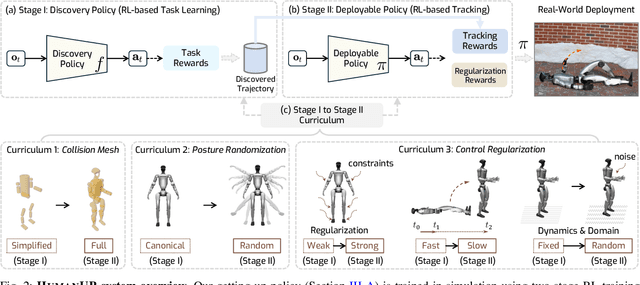
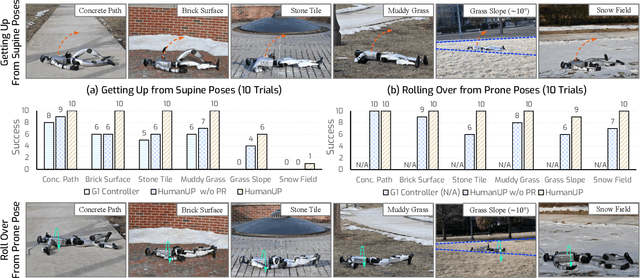
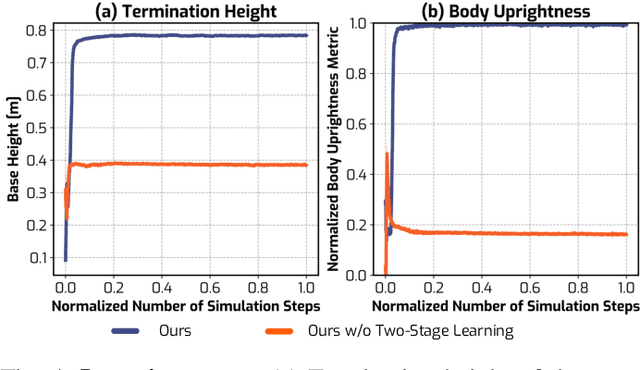
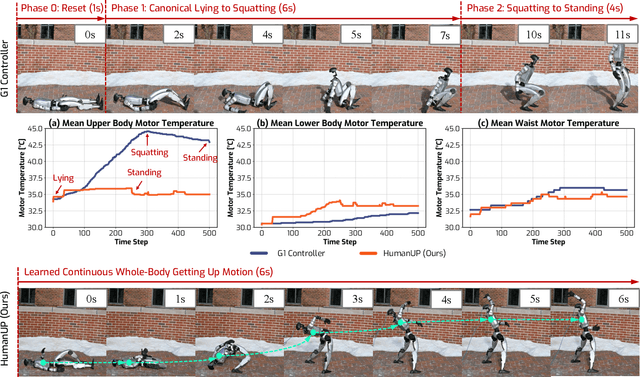
Abstract:Automatic fall recovery is a crucial prerequisite before humanoid robots can be reliably deployed. Hand-designing controllers for getting up is difficult because of the varied configurations a humanoid can end up in after a fall and the challenging terrains humanoid robots are expected to operate on. This paper develops a learning framework to produce controllers that enable humanoid robots to get up from varying configurations on varying terrains. Unlike previous successful applications of humanoid locomotion learning, the getting-up task involves complex contact patterns, which necessitates accurately modeling the collision geometry and sparser rewards. We address these challenges through a two-phase approach that follows a curriculum. The first stage focuses on discovering a good getting-up trajectory under minimal constraints on smoothness or speed / torque limits. The second stage then refines the discovered motions into deployable (i.e. smooth and slow) motions that are robust to variations in initial configuration and terrains. We find these innovations enable a real-world G1 humanoid robot to get up from two main situations that we considered: a) lying face up and b) lying face down, both tested on flat, deformable, slippery surfaces and slopes (e.g., sloppy grass and snowfield). To the best of our knowledge, this is the first successful demonstration of learned getting-up policies for human-sized humanoid robots in the real world. Project page: https://humanoid-getup.github.io/
Learning Smooth Humanoid Locomotion through Lipschitz-Constrained Policies
Oct 15, 2024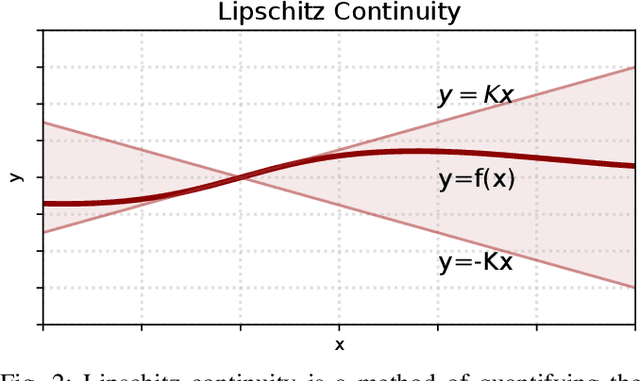
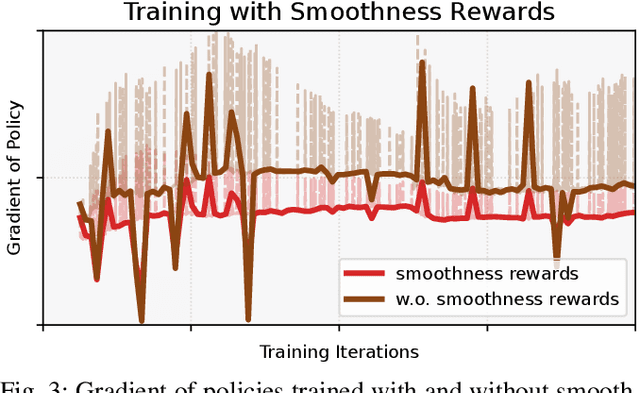

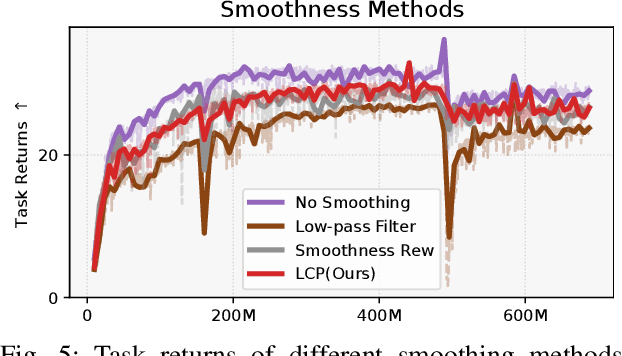
Abstract:Reinforcement learning combined with sim-to-real transfer offers a general framework for developing locomotion controllers for legged robots. To facilitate successful deployment in the real world, smoothing techniques, such as low-pass filters and smoothness rewards, are often employed to develop policies with smooth behaviors. However, because these techniques are non-differentiable and usually require tedious tuning of a large set of hyperparameters, they tend to require extensive manual tuning for each robotic platform. To address this challenge and establish a general technique for enforcing smooth behaviors, we propose a simple and effective method that imposes a Lipschitz constraint on a learned policy, which we refer to as Lipschitz-Constrained Policies (LCP). We show that the Lipschitz constraint can be implemented in the form of a gradient penalty, which provides a differentiable objective that can be easily incorporated with automatic differentiation frameworks. We demonstrate that LCP effectively replaces the need for smoothing rewards or low-pass filters and can be easily integrated into training frameworks for many distinct humanoid robots. We extensively evaluate LCP in both simulation and real-world humanoid robots, producing smooth and robust locomotion controllers. All simulation and deployment code, along with complete checkpoints, is available on our project page: https://lipschitz-constrained-policy.github.io.
Visual Manipulation with Legs
Oct 15, 2024Abstract:Animals use limbs for both locomotion and manipulation. We aim to equip quadruped robots with similar versatility. This work introduces a system that enables quadruped robots to interact with objects using their legs, inspired by non-prehensile manipulation. The system has two main components: a visual manipulation policy module and a loco-manipulator module. The visual manipulation policy, trained with reinforcement learning (RL) using point cloud observations and object-centric actions, decides how the leg should interact with the object. The loco-manipulator controller manages leg movements and body pose adjustments, based on impedance control and Model Predictive Control (MPC). Besides manipulating objects with a single leg, the system can select from the left or right leg based on critic maps and move objects to distant goals through base adjustment. Experiments evaluate the system on object pose alignment tasks in both simulation and the real world, demonstrating more versatile object manipulation skills with legs than previous work.
Generalizable Humanoid Manipulation with Improved 3D Diffusion Policies
Oct 14, 2024



Abstract:Humanoid robots capable of autonomous operation in diverse environments have long been a goal for roboticists. However, autonomous manipulation by humanoid robots has largely been restricted to one specific scene, primarily due to the difficulty of acquiring generalizable skills. Recent advances in 3D visuomotor policies, such as the 3D Diffusion Policy (DP3), have shown promise in extending these capabilities to wilder environments. However, 3D visuomotor policies often rely on camera calibration and point-cloud segmentation, which present challenges for deployment on mobile robots like humanoids. In this work, we introduce the Improved 3D Diffusion Policy (iDP3), a novel 3D visuomotor policy that eliminates these constraints by leveraging egocentric 3D visual representations. We demonstrate that iDP3 enables a full-sized humanoid robot to autonomously perform skills in diverse real-world scenarios, using only data collected in the lab. Videos are available at: https://humanoid-manipulation.github.io
OmniH2O: Universal and Dexterous Human-to-Humanoid Whole-Body Teleoperation and Learning
Jun 13, 2024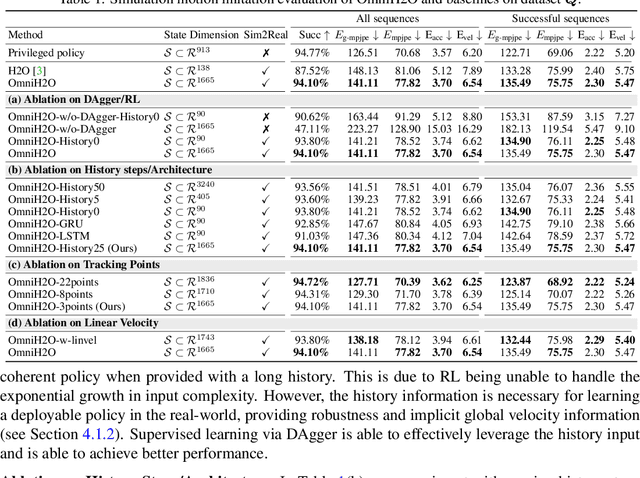
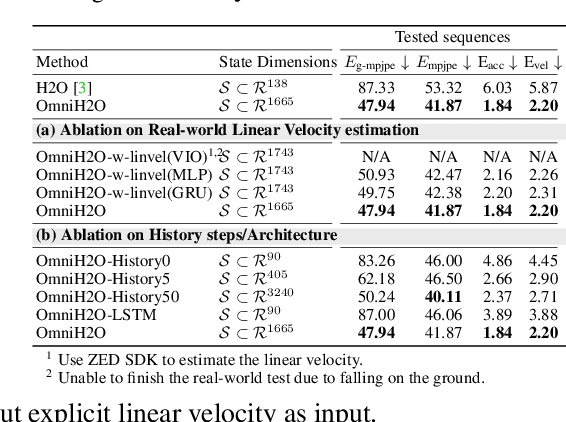
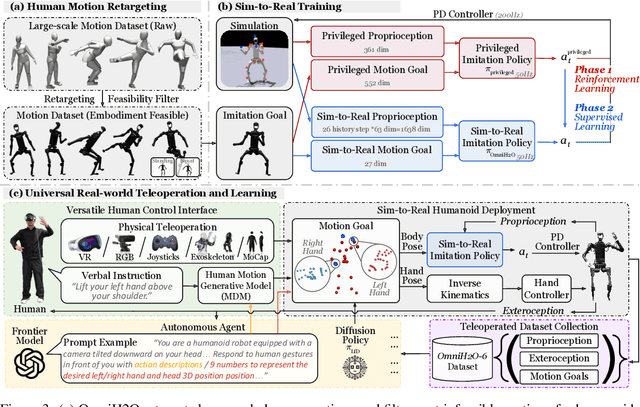
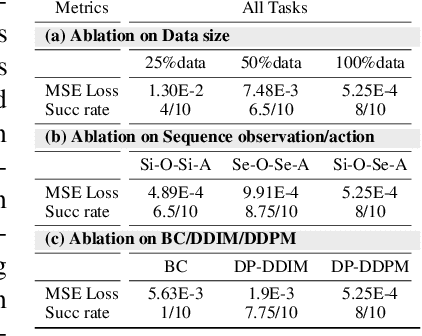
Abstract:We present OmniH2O (Omni Human-to-Humanoid), a learning-based system for whole-body humanoid teleoperation and autonomy. Using kinematic pose as a universal control interface, OmniH2O enables various ways for a human to control a full-sized humanoid with dexterous hands, including using real-time teleoperation through VR headset, verbal instruction, and RGB camera. OmniH2O also enables full autonomy by learning from teleoperated demonstrations or integrating with frontier models such as GPT-4. OmniH2O demonstrates versatility and dexterity in various real-world whole-body tasks through teleoperation or autonomy, such as playing multiple sports, moving and manipulating objects, and interacting with humans. We develop an RL-based sim-to-real pipeline, which involves large-scale retargeting and augmentation of human motion datasets, learning a real-world deployable policy with sparse sensor input by imitating a privileged teacher policy, and reward designs to enhance robustness and stability. We release the first humanoid whole-body control dataset, OmniH2O-6, containing six everyday tasks, and demonstrate humanoid whole-body skill learning from teleoperated datasets.
Sim-to-Real Transfer for Quadrupedal Locomotion via Terrain Transformer
Dec 15, 2022Abstract:Deep reinforcement learning has recently emerged as an appealing alternative for legged locomotion over multiple terrains by training a policy in physical simulation and then transferring it to the real world (i.e., sim-to-real transfer). Despite considerable progress, the capacity and scalability of traditional neural networks are still limited, which may hinder their applications in more complex environments. In contrast, the Transformer architecture has shown its superiority in a wide range of large-scale sequence modeling tasks, including natural language processing and decision-making problems. In this paper, we propose Terrain Transformer (TERT), a high-capacity Transformer model for quadrupedal locomotion control on various terrains. Furthermore, to better leverage Transformer in sim-to-real scenarios, we present a novel two-stage training framework consisting of an offline pretraining stage and an online correction stage, which can naturally integrate Transformer with privileged training. Extensive experiments in simulation demonstrate that TERT outperforms state-of-the-art baselines on different terrains in terms of return, energy consumption and control smoothness. In further real-world validation, TERT successfully traverses nine challenging terrains, including sand pit and stair down, which can not be accomplished by strong baselines.
 Add to Chrome
Add to Chrome Add to Firefox
Add to Firefox Add to Edge
Add to Edge